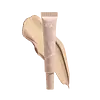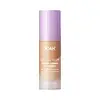What's inside
What's inside
 Key Ingredients
Key Ingredients

 Benefits
Benefits

 Concerns
Concerns

 Ingredients Side-by-side
Ingredients Side-by-side

Water
Skin ConditioningDimethicone
EmollientEthyl Trisiloxane
Skin ConditioningGlycerin
HumectantPhenyl Trimethicone
Skin ConditioningPropanediol
SolventLauryl Polyglyceryl-3 Polydimethylsiloxyethyl Dimethicone
Skin ConditioningCaprylyl Methicone
Skin ConditioningNiacinamide
SmoothingMica
Cosmetic ColorantTrimethylsiloxysilicate
EmollientDisteardimonium Hectorite
StabilisingSodium Chloride
MaskingZantedeschia Elliottiana Flower Extract
AntioxidantBakuchiol
AntimicrobialCaprylic/Capric Triglyceride
MaskingPhenoxyethanol
PreservativeC30-45 Alkyl Cetearyl Dimethicone Crosspolymer
EmollientDimethicone/Polyglycerin-3 Crosspolymer
CleansingTriethoxycaprylylsilane
Aluminum Hydroxide
EmollientEthylhexylglycerin
Skin ConditioningMethicone
EmollientDipropylene Glycol
HumectantSodium Citrate
BufferingTocopherol
AntioxidantTitanium Dioxide
Cosmetic ColorantCI 77491
Cosmetic ColorantCI 77492
Cosmetic ColorantCI 77499
Cosmetic ColorantWater, Dimethicone, Ethyl Trisiloxane, Glycerin, Phenyl Trimethicone, Propanediol, Lauryl Polyglyceryl-3 Polydimethylsiloxyethyl Dimethicone, Caprylyl Methicone, Niacinamide, Mica, Trimethylsiloxysilicate, Disteardimonium Hectorite, Sodium Chloride, Zantedeschia Elliottiana Flower Extract, Bakuchiol, Caprylic/Capric Triglyceride, Phenoxyethanol, C30-45 Alkyl Cetearyl Dimethicone Crosspolymer, Dimethicone/Polyglycerin-3 Crosspolymer, Triethoxycaprylylsilane, Aluminum Hydroxide, Ethylhexylglycerin, Methicone, Dipropylene Glycol, Sodium Citrate, Tocopherol, Titanium Dioxide, CI 77491, CI 77492, CI 77499
Water
Skin ConditioningPhenyl Trimethicone
Skin ConditioningButylene Glycol
HumectantDimethicone
EmollientCetyl PEG/PPG-10/1 Dimethicone
EmulsifyingOrbignya Oleifera Seed Oil
EmollientCyclopentasiloxane
EmollientButylene Glycol Dicaprylate/Dicaprate
EmollientButyloctyl Salicylate
Skin ConditioningGlycerin
HumectantDipropylene Glycol
HumectantMagnesium Sulfate
Cyclohexasiloxane
Emollient1,2-Hexanediol
Skin ConditioningAluminum Hydroxide
EmollientAnthemis Nobilis Flower Oil
MaskingCalcium Stearate
Cosmetic ColorantCaprylic/Capric Triglyceride
MaskingCerium Oxide
Cetyl Palmitate
EmollientCitric Acid
BufferingCollagen
MoisturisingDimethicone/Vinyl Dimethicone Crosspolymer
Skin ConditioningDisodium EDTA
Disteardimonium Hectorite
StabilisingEthylhexyl Palmitate
EmollientEthylhexylglycerin
Skin ConditioningHelianthus Annuus Seed Oil
EmollientHexyl Laurate
EmollientHyaluronic Acid
HumectantHydrogenated Lecithin
EmulsifyingHydrolyzed Hyaluronic Acid
HumectantIsopropyl Myristate
EmollientIsostearic Acid
CleansingLecithin
EmollientLeuconostoc/Radish Root Ferment Filtrate
AntimicrobialPalmitoyl Tetrapeptide-10
Skin ConditioningPolyglyceryl-3 Polyricinoleate
EmulsifyingPolyglyceryl-4 Isostearate
EmulsifyingPolyhydroxystearic Acid
EmulsifyingPolysorbate 80
EmulsifyingPotassium Sorbate
PreservativePropanediol
SolventPropylene Carbonate
SolventSilica
AbrasiveSodium Benzoate
MaskingSodium Chloride
MaskingSodium Hyaluronate
HumectantSorbitan Isostearate
EmulsifyingSorbitan Stearate
EmulsifyingStearic Acid
CleansingTocopherol
AntioxidantTocopheryl Acetate
AntioxidantTriethoxycaprylylsilane
Triethyl Citrate
MaskingTromethamine
BufferingTitanium Dioxide
Cosmetic ColorantCI 77492
Cosmetic ColorantWater, Phenyl Trimethicone, Butylene Glycol, Dimethicone, Cetyl PEG/PPG-10/1 Dimethicone, Orbignya Oleifera Seed Oil, Cyclopentasiloxane, Butylene Glycol Dicaprylate/Dicaprate, Butyloctyl Salicylate, Glycerin, Dipropylene Glycol, Magnesium Sulfate, Cyclohexasiloxane, 1,2-Hexanediol, Aluminum Hydroxide, Anthemis Nobilis Flower Oil, Calcium Stearate, Caprylic/Capric Triglyceride, Cerium Oxide, Cetyl Palmitate, Citric Acid, Collagen, Dimethicone/Vinyl Dimethicone Crosspolymer, Disodium EDTA, Disteardimonium Hectorite, Ethylhexyl Palmitate, Ethylhexylglycerin, Helianthus Annuus Seed Oil, Hexyl Laurate, Hyaluronic Acid, Hydrogenated Lecithin, Hydrolyzed Hyaluronic Acid, Isopropyl Myristate, Isostearic Acid, Lecithin, Leuconostoc/Radish Root Ferment Filtrate, Palmitoyl Tetrapeptide-10, Polyglyceryl-3 Polyricinoleate, Polyglyceryl-4 Isostearate, Polyhydroxystearic Acid, Polysorbate 80, Potassium Sorbate, Propanediol, Propylene Carbonate, Silica, Sodium Benzoate, Sodium Chloride, Sodium Hyaluronate, Sorbitan Isostearate, Sorbitan Stearate, Stearic Acid, Tocopherol, Tocopheryl Acetate, Triethoxycaprylylsilane, Triethyl Citrate, Tromethamine, Titanium Dioxide, CI 77492
Ingredients Explained
These ingredients are found in both products.
Ingredients higher up in an ingredient list are typically present in a larger amount.
Aluminum Hydroxide is a form of aluminum. It can be naturally found in nature as the mineral gibbsite. In cosmetics, Aluminum Hydroxide is used as a colorant, pH adjuster, and absorbent.
As a colorant, Aluminum Hydroxide may add opacity, or reduce the transparency. Aluminum hydroxide is contains both basic and acidic properties.
According to manufacturers, this ingredient is an emollient and humectant. This means it helps hydrate the skin.
In medicine, this ingredient is used to help relieve heartburn and help heal ulcers.
There is currently no credible scientific evidence linking aluminum hydroxide in cosmetics to increased cancer risk.
Major health organizations allow the use of aluminum hydroxide in personal care products and have not flagged it as a carcinogenic risk at typical usage levels.
Learn more about Aluminum HydroxideThis ingredient is an emollient, solvent, and texture enhancer. It is considered a skin-softener by helping the skin prevent moisture loss.
It helps thicken a product's formula and makes it easier to spread by dissolving clumping compounds.
Caprylic Triglyceride is made by combining glycerin with coconut oil, forming a clear liquid.
While there is an assumption Caprylic Triglyceride can clog pores due to it being derived from coconut oil, there is no research supporting this.
Learn more about Caprylic/Capric TriglycerideCi 77492 is also hydrated iron III oxide. It's sole purpose is to give a yellow hue to products.
Iron III oxides are classified as inorganic chemicals for coloring.
Synthetically created Ci 77492 is considered safer than those naturally found. This is because the synthetically created version may contain less impurities. Iron oxides are generally non-toxic and non-allergenic.
Learn more about CI 77492Dimethicone is a type of synthetic silicone created from natural materials such as quartz.
What it does:
Dimethicone comes in different viscosities:
Depending on the viscosity, dimethicone has different properties.
Ingredients lists don't always show which type is used, so we recommend reaching out to the brand if you have questions about the viscosity.
This ingredient is unlikely to cause irritation because it does not get absorbed into skin. However, people with silicone allergies should be careful about using this ingredient.
Note: Dimethicone may contribute to pilling. This is because it is not oil or water soluble, so pilling may occur when layered with products. When mixed with heavy oils in a formula, the outcome is also quite greasy.
Learn more about DimethiconeDipropylene Glycol is a synthetically created humectant, stabilizer, and solvent.
This ingredient helps:
Dipropylene glycol is technically an alcohol, but it belongs to the glycol family (often considered part of the ‘good’ alcohols). This means it is hydrating and gentle on skin unlike drying solvent alcohols like denatured alcohol.
As a masking agent, Dipropylene Glycol can be used to cover the smell of other ingredients. However, it does not have a scent.
Studies show Dipropylene Glycol is considered safe to use in skincare.
Learn more about Dipropylene GlycolDisteardimonium Hectorite comes from the clay mineral named hectorite. It is used to add thickness to a product.
It can also help stabilize a product by helping to disperse other ingredients.
Hectorite is a rare, white clay mineral.
Learn more about Disteardimonium HectoriteEthylhexylglycerin (we can't pronounce this either) is commonly used as a preservative and skin softener. It is derived from glyceryl.
You might see Ethylhexylglycerin often paired with other preservatives such as phenoxyethanol. Ethylhexylglycerin has been found to increase the effectiveness of these other preservatives.
Glycerin is already naturally found in your skin. It helps moisturize and protect your skin.
A study from 2016 found glycerin to be more effective as a humectant than AHAs and hyaluronic acid.
As a humectant, it helps the skin stay hydrated by pulling moisture to your skin. The low molecular weight of glycerin allows it to pull moisture into the deeper layers of your skin.
Hydrated skin improves your skin barrier; Your skin barrier helps protect against irritants and bacteria.
Glycerin has also been found to have antimicrobial and antiviral properties. Due to these properties, glycerin is often used in wound and burn treatments.
In cosmetics, glycerin is usually derived from plants such as soybean or palm. However, it can also be sourced from animals, such as tallow or animal fat.
This ingredient is organic, colorless, odorless, and non-toxic.
Glycerin is the name for this ingredient in American English. British English uses Glycerol/Glycerine.
Learn more about GlycerinPhenyl Trimethicone is a silicon-based polymer. It is derived from silica.
Phenyl Trimethicone is used as an emollient and prevents products from foaming.
As an emollient, it helps trap moisture in the skin. It is considered an occlusive.
Learn more about Phenyl TrimethiconePropanediol is an all-star ingredient. It softens, hydrates, and smooths the skin.
It’s often used to:
Propanediol is not likely to cause sensitivity and considered safe to use. It is derived from corn or petroleum with a clear color and no scent.
Learn more about PropanediolChances are, you eat sodium chloride every day. Sodium Chloride is also known as table salt.
This ingredient has many purposes in skincare: thickener, emulsifier, and exfoliator.
You'll most likely find this ingredient in cleansers where it is used to create a gel-like texture. As an emulsifier, it also prevents ingredients from separating.
There is much debate on whether this ingredient is comedogenic. The short answer - comedogenic ratings don't tell the whole story. Learn more about comegodenic ratings here.
The concensus about this ingredient causing acne seems to be divided. Research is needed to understand if this ingredient does cause acne.
Scrubs may use salt as the primary exfoliating ingredient.
Learn more about Sodium ChlorideTitanium dioxide is a mineral UV filter widely used in sunscreens and cosmetics.
It is one of only two UV filters officially classified as “mineral” by regulatory agencies, the other being zinc oxide.
Titanium dioxide provides broad-spectrum protection mostly in the UVB and UVAII range, with some protection in the UVAI range.
While its UVA protection isn’t as strong as zinc oxide’s, the difference is minor.
A common myth is that mineral UV filters reflect UV light. However, modern research shows titanium dioxide absorbs UV radiation like chemical filters (~95% absorption & 5% reflection).
Thanks to its non-irritating nature, titanium dioxide is suitable for sensitive, acne-prone, or redness-prone skin. It is unlikely to cause "eye sting" like other sunscreen ingredients.
A major drawback of this ingredient is its white cast and thick texture. This is why mineral sunscreens often leave a white cast and are less cosmetically elegant than chemical/hybrid sunscreens.
To improve white cast and spreadability, micronized or nano-sized titanium dioxide is often used.
There are ongoing concerns surrounding nano-titanium oxide's impact on marine ecosystems.
There is no conclusive evidence that any form of titanium oxide (or any other sunscreen ingredients) will cause harm to marine ecosystems or coral reefs. The science is still developing but many consumers are keeping a close eye on this issue.
Please note, many destinations have reef-safety sunscreen rules. For instance, the U.S. Virgin Islands advises all visitors to use non-nano mineral sunscreens.
Nano mineral sunscreens once raised safety concerns about absorption into skin.
Extensive research has shown that they do not penetrate healthy or damaged skin; they remain safely on the surface and the top layer of dead skin (stratum corneum).
You'll likely find titanium dioxide bundled with alumina, silica, or dimethicone. These ingredients help make titanium dioxide highly photostable; this prevents it from interacting with other formula components under UV light.
Learn more about Titanium DioxideTocopherol (also known as Vitamin E) is a common antioxidant used to help protect the skin from free-radicals and strengthen the skin barrier. It's also fat soluble - this means our skin is great at absorbing it.
Vitamin E also helps keep your natural skin lipids healthy. Your lipid skin barrier naturally consists of lipids, ceramides, and fatty acids. Vitamin E offers extra protection for your skin’s lipid barrier, keeping your skin healthy and nourished.
Another benefit is a bit of UV protection. Vitamin E helps reduce the damage caused by UVB rays. (It should not replace your sunscreen). Combining it with Vitamin C can decrease sunburned cells and hyperpigmentation after UV exposure.
You might have noticed Vitamin E + C often paired together. This is because it is great at stabilizing Vitamin C. Using the two together helps increase the effectiveness of both ingredients.
There are often claims that Vitamin E can reduce/prevent scarring, but these claims haven't been confirmed by scientific research.
Learn more about TocopherolTriethoxycaprylylsilane is a silicone used to bind and stabilize ingredients.
As an emulsifier, it helps prevent ingredients from separating. This can help elongate the shelf life of products.
Triethoxycaprylylsilane is often used to coat mineral sunscreens ingredients to help give a better feel. It also helps reduce oxidative stress in sunscreens.
Learn more about TriethoxycaprylylsilaneWater. It's the most common cosmetic ingredient of all. You'll usually see it at the top of ingredient lists, meaning that it makes up the largest part of the product.
So why is it so popular? Water most often acts as a solvent - this means that it helps dissolve other ingredients into the formulation.
You'll also recognize water as that liquid we all need to stay alive. If you see this, drink a glass of water. Stay hydrated!
Learn more about Water